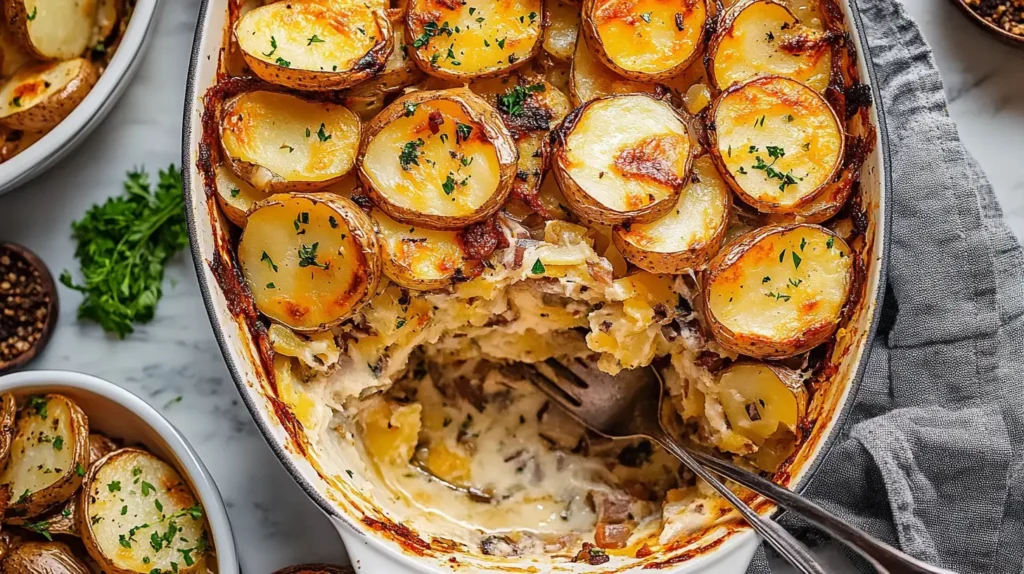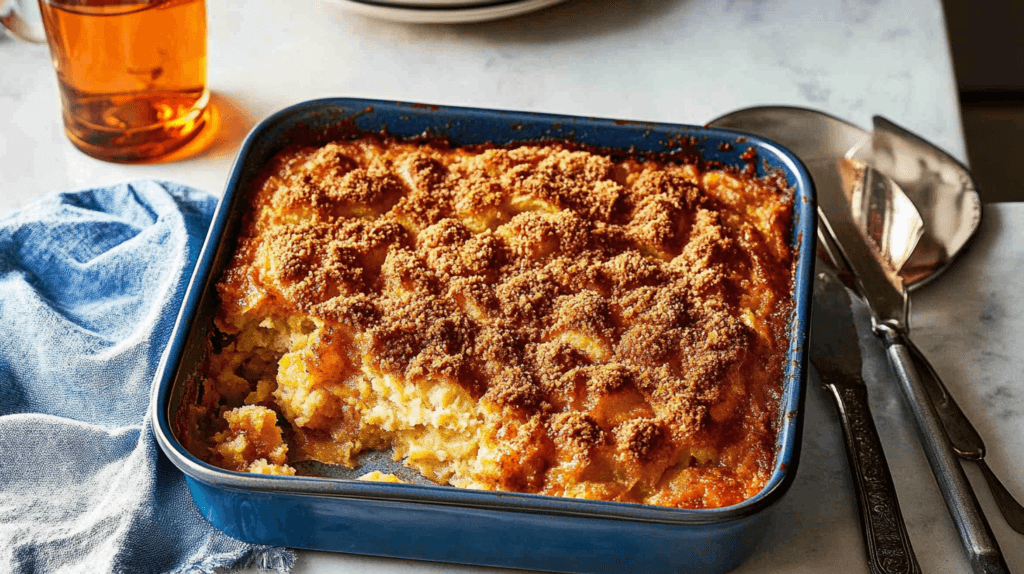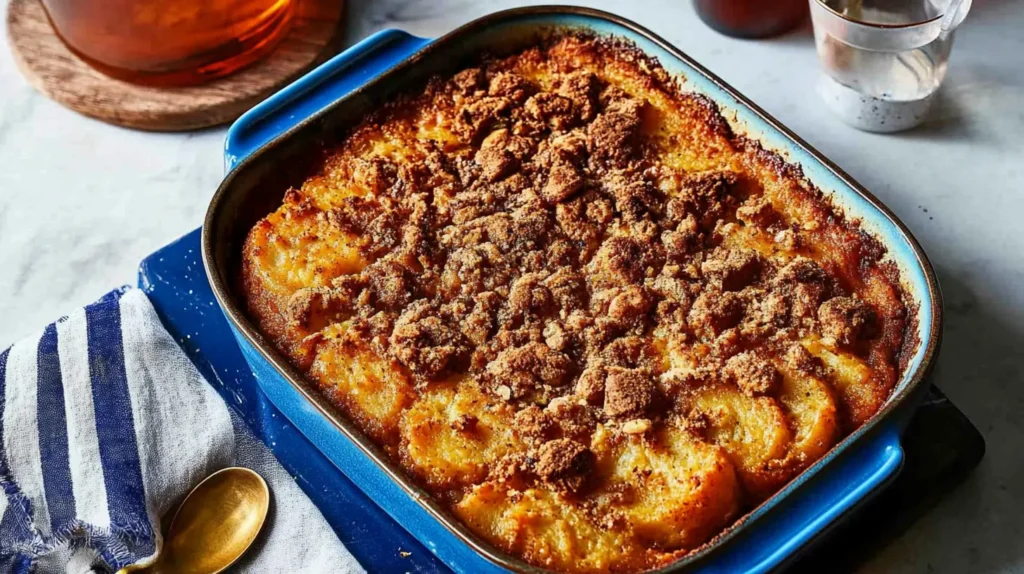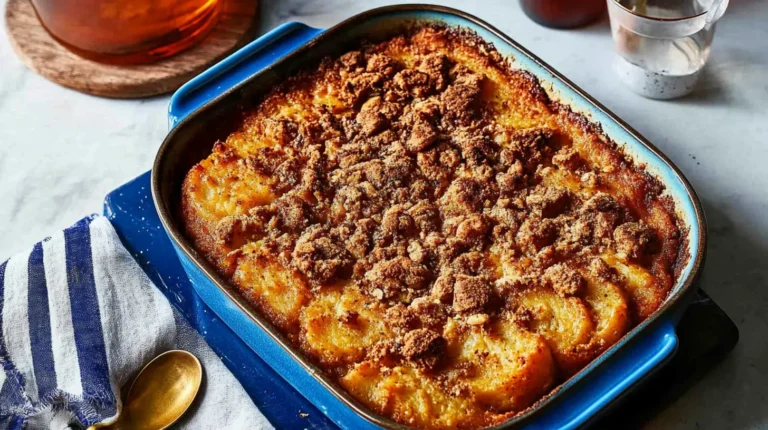
Definitions of Casserole and Soufflé
Before we start ,in this blog, I provide free recipes that anyone can try, whether you’re a beginner or a seasoned home cook. I believe that cooking should be fun, rewarding, and most importantly, delicious! So, join me as I share my favorite dishes, tips, and kitchen experiments.You may like trendy recipes like The potato soufflé step by step article , or just explore the recipe Menu. Let’s cook up something amazing together!
When it comes to classic comfort food, two dishes often come to mind: casseroles and soufflés. Though they may sound similar to the uninitiated, these culinary delights present distinct characteristics that make each one special. Let’s dive into their definitions and uncover their unique qualities!
Definition of Casserole
At its core, a casserole is a dish that combines various ingredients, typically cooked slowly in a deep dish. This versatile cooking method allows for rich flavors to meld together. I still remember the smell of my grandmother’s chicken and rice casserole bubbling away in the oven on chilly Sunday afternoons.
“Every casserole I make takes me back to my grandmother’s kitchen, where the comforting smells of chicken and rice bubbling in the oven reminded me that food can be the ultimate hug in a dish.”
Here’s what defines a casserole:
- Ingredients: Casseroles can include an array of ingredients, such as meats, vegetables, grains, and sauces. Common choices are chicken, tuna, and seasoned vegetables mixed with a creamy sauce.
- Preparation Method: Typically baked in an oven, casseroles are usually assembled in advance and then cooked together in one dish. This makes them an easy go-to for busy weeknight dinners or family gatherings.
- Texture and Taste: The slow cooking process allows the flavors to infuse, yielding a hearty, satisfying texture—think savory, creamy, and often cheesy!
- Serving size: Casseroles are perfect for sharing, making them a stellar choice for potlucks and family gatherings. You can easily delight a crowd with just one dish.
Definition of Soufflé

On the flip side, a soufflé is often associated with elegance and culinary finesse. This dish is light, airy, and primarily made with eggs, which provides its unique structure and fluffiness. It’s a staple in French cuisine and can be served as either a savory main dish or a decadent dessert.
Here’s what sets a soufflé apart:
- Ingredients: The main ingredient is, without a doubt, eggs. They provide the lift and light texture, complemented often by cheese, chocolate, or fruits. For instance, a cheese soufflé incorporates grated cheese and seasonings.
- Preparation Method: Preparing a soufflé requires separating the egg whites from yolks. The egg whites are whipped to soft peaks and then folded back into the mixture to create that delightful rise when baked.
- Texture and Taste: The result is a dish that is incredibly soft and airy, with a delicate crust on the outside. Imagine savoring a silky chocolate soufflé that melts in your mouth with every bite!
- Serving style: Unlike casseroles that are typically served in the baking dish, soufflés should be served immediately after coming out of the oven to maintain their airy structure.
In the culinary world, both casseroles and soufflés demonstrate creativity, flavor, and comfort in unique ways. Whether you’re indulging in a warm, cheesy casserole or delighting in a sophisticated soufflé, each dish holds its own space in the hearts—and stomachs—of many home cooks and food lovers alike.
I hope my journey into these two styles of cooking has inspired you to explore casserole and soufflé recipes in your kitchen!
Ingredients and Preparation Methods
After diving into the definitions of casseroles and soufflés, it’s time to explore the heart of these dishes: their ingredients and the preparation methods we use to bring them to life. Each dish showcases a unique set of ingredients that contribute to its beloved flavors and textures. Let’s get cooking!
The first time I made a soufflé, I was nervous—would it rise or fall flat? Watching it puff up perfectly in the oven was nothing short of magical, and the delicate texture made all the effort worth it!”
Ingredients used in Casseroles
Casseroles are all about variety and comfort. They often contain a mix of savory ingredients, resulting in a hearty dish perfect for sharing. Here’s a breakdown of common ingredients you can find in casseroles:
- Proteins: Chicken, beef, pork, or seafood are often the star ingredients. My family loves a creamy chicken and mushroom casserole that’s filled with tender bites of chicken.
- Vegetables: Carrots, peas, green beans, and corn are popular choices. Roasted vegetables can also add a deeper flavor profile.
- Grains: Rice, pasta, or potatoes serve as excellent base ingredients, helping to balance the dish and add substance.
- Sauces: Cream-based sauces, tomato sauces, or broth can add moisture and flavor. I once experimented with a cheesy sauce that took my casserole to the next level!
- Cheese: A sprinkle of cheese on the top often tantalizes taste buds, creating a delightful melted layer that’s hard to resist.
✅ Table of Common Casserole Ingredients
| Ingredient Type | Examples |
|---|---|
| Proteins | Chicken, beef, tuna |
| Vegetables | Green beans, carrots, peas |
| Grains | Rice, pasta, potatoes |
| Sauces | Cream of mushroom, marinara |
| Cheese | Cheddar, mozzarella, parmesan |
Ingredients used in Soufflés
Unlike casseroles, soufflés shine with their lightness and fluffy texture, primarily due to a few essential ingredients, most notably eggs. Here’s what you typically find in a classic soufflé:
- Eggs: The fundamental component, egg whites are beaten to peaks, providing that airy rise.
- Base Ingredients: Depending on the type, you might find cheese for savory soufflés or chocolate and sugar for dessert versions.
- Flavorings: For savory soufflés, you’ll likely add herbs or spices, while dessert soufflés might contain vanilla or cinnamon for warmth.
- Liquid: Cream or milk is often incorporated for richness and creaminess.
My first attempt at a chocolate soufflé was nerve-wracking yet thrilling! The aroma wafting from the oven made all the effort worthwhile as I watched it rise.
Different cooking techniques for Casseroles and Soufflés
The preparation methods for casseroles and soufflés also contrast significantly.
For casseroles:
- Assembly: You layer the ingredients in a deep dish, ensuring even distribution.
- Baking: Once everything is combined, the casserole is baked until it’s bubbly and golden brown on top.
For soufflés:
- Whipping: The egg whites must be whipped carefully to achieve the right consistency.
- Folding: You gently fold the whipped egg whites into the base mixture, taking care not to deflate the air you’ve worked so hard to incorporate.
- Baking: Like casseroles, soufflés are baked, but they require precise timings and temperatures to achieve that impressive puffy appearance.
Both dishes hold a significant place in our culinary hearts! As I’ve learned, whether it’s the comfort of a casserole or the elegance of a soufflé, there’s a world of flavors waiting to be explored. So roll up those sleeves and get ready to create delicious memories in your kitchen!
Texture and Presentation
As we dive into the delightful world of casseroles and soufflés, it’s crucial to understand how texture and presentation play significant roles in elevating these dishes. While both offer comfort and flavor, their textures and visual appeal set them apart. Let’s explore these elements further!
Texture of Casseroles
Casseroles are hearty and comforting, often providing a rustic texture that feels like a warm hug in a dish. This texture comes from the combination of various ingredients, typically mixed together and baked until everything is melded and flavorful. Here’s a closer look:
- Creamy and Chunky: Many casseroles feature layers of creamy sauces and chunky vegetables or proteins. Think of a creamy chicken and rice casserole, where each forkful delivers a satisfying blend of flavors.
- Hearty and Substantial: The presence of grains or pasta offers a filling texture. When I serve a cheesy potato casserole to my family, I love how the generous layers of potatoes and cheese come together to create something truly comforting.
- Golden-Brown Crust: Often, the top of a casserole becomes beautifully browned and crispy during baking, providing a lovely contrast to the soft layers beneath it.
Casseroles may not be known for their lightness, but that’s their charm—a warm, welcoming dish that’s perfect for potlucks and busy weeknight dinners!
Texture of Soufflés
On the other hand, soufflés are all about the airy and delicate texture that feels like a cloud on your palate. Here’s what makes soufflés so unique:
- Light and Fluffy: The key to a successful soufflé lies in the whipped egg whites, which create an outstanding lift. When done right, a soufflé should be incredibly light and tender. I still remember the joy of serving my first chocolate soufflé—watching it rise in the oven was like magic!
- Delicate Smoothness: Unlike casseroles that have chunkier components, soufflés are often smooth and creamy inside, providing a velvety mouthfeel. The combination of whipped egg whites and additional flavoring (like cheese or chocolate) gives you that luscious experience.
- Crisp Exterior: When baked, soufflés develop a golden-brown, slightly crisp outer layer that contrasts beautifully with the tender center.
Presentation Differences between Casseroles and Soufflés
Presentation is an essential component of any dish, and casseroles and soufflés do have a striking contrast in how they are served:
- Casseroles: Typically served directly from the baking dish, casseroles can appear homey and satisfying. They are often heaped generously onto plates, showcasing their hearty ingredients. A wonderfully cheesy casserole with crispy edges can make my mouth water just by looking at it!
- Soufflés: In stark contrast, soufflés need to be served immediately after baking to maintain their impressive height. Dished out from a soufflé dish, their elegant rise is a key visual element. Ideally, they should be presented in beautiful ramekins to showcase their fluffiness.
When preparing your next meal, remember that both casseroles and soufflés provide unique textures and presentations that delight the senses in different ways. Whether it’s the creamy blend of a casserole or the airy fluff of a soufflé, there’s something special about each dish, and I can’t wait to whip up both during my next dinner gathering!
Variations and Regional Differences
Diving into the realm of casseroles and soufflés opens up an exciting world of culinary variety, showcasing the creativity and preferences of different cultures. Let’s explore the delicious variations of casseroles around the globe and the intriguing regional differences in soufflé recipes.
Different Variations of Casseroles Worldwide
Casseroles are beloved in many cuisines, often adapted to reflect local ingredients and flavors. Here’s a look at some popular variations of casseroles from around the world:
- Green Bean Casserole (United States): This Thanksgiving classic combines green beans, cream of mushroom soup, and crispy fried onions. My family never fails to make this dish! Its rich creaminess and crunch on top always steal the show.
- Moussaka (Greece): Moussaka is a comforting baked casserole featuring layers of eggplant, ground meat, and béchamel sauce. It’s perfect for sharing during family gatherings, and its rich flavors make it an unforgettable meal.
- Rösti (Switzerland): This Swiss dish consists of grated potatoes that are fried or baked until crispy. Often served as a side dish, rösti can be topped with cheese, vegetables, or meats—all delicious options!
- Lasagna (Italy): Layers of pasta, cheese, tomato sauce, and meat make lasagna a classic Italian casserole. I remember helping my mom prepare lasagna on special occasions, carefully layering each component, knowing it would be a hit with family and friends.
- Shepherd’s Pie (United Kingdom): This savory dish features minced lamb or beef topped with creamy mashed potatoes and baked until golden. It’s a staple comfort food that warms the heart.
With so many variations out there, it’s no wonder casseroles are a go-to choice for potlucks and family meals!
Regional Differences in Soufflé Recipes
Soufflés showcase the artistry of cooking, with variations that reflect local traditions and flavors. Here are some notable regional differences in soufflé recipes:
- Cheese Soufflé (France): This quintessential French dish highlights the rich flavors of cheese, often made with gruyère or emmental. Cheese soufflés are delicate yet flavorful, served as a sophisticated appetizer. I had the pleasure of enjoying one at a quaint French café, and its airy texture left an imprint on my taste buds.
- Chocolate Soufflé (France): Another French classic, the chocolate soufflé makes a decadent dessert that melts in your mouth. Made with high-quality chocolate and whipped egg whites, it’s a dreamy treat to end any meal.
- Pumpkin Soufflé (United States): In the U.S., especially during the fall, pumpkin soufflés show up on tables to celebrate the season. This variation often incorporates warm spices like cinnamon and nutmeg, adding a cozy and festive element that reminds me of autumn gatherings with family.
- Paprika Soufflé (Hungary): Hungarian variations can blend traditional ingredients, like paprika, to create savory soufflés with a pop of flavor that’s distinctly Eastern European.
- Vegetable Soufflé (Australia): Down under, you might find variations that emphasize local produce. Veggie-packed soufflés can serve as a light and healthy alternative.
These regional differences illustrate how diverse and versatile soufflés can be, adapting to cultures and preferences while maintaining their core characteristics.
Exploring the world of casseroles and soufflés invites us to discover traditions, flavors, and memories. Each dish holds stories of comfort, celebration, and creativity from kitchens around the globe. I can’t wait to create my own versions inspired by these global flavors!
Serving and Pairing
Now that we’ve explored the variations and regional differences of casseroles and soufflés, it’s time to discuss how to serve and pair these delightful dishes. Understanding the best occasions for casseroles and the ideal companions for soufflés can elevate your dining experience. Let’s dive in!
“In my kitchen, casseroles are the go-to for family gatherings—hearty, cheesy, and full of love. Soufflés, on the other hand, bring a touch of elegance, making me feel like a French chef every time I watch that fluffy rise!”
Suitable Occasions for Serving Casseroles
Casseroles shine in various settings, offering comfort and ease for gatherings and everyday meals alike. Here are some occasions where casseroles truly shine:
- Family Gatherings: Think of those holidays where everyone gathers around the table to enjoy a feast. Casseroles make the perfect addition, as they can be prepared ahead of time and baked just before serving. I remember Thanksgiving dinners where my family’s green bean casserole was a must-have on the table!
- Potluck Parties: Casseroles are ideal for potlucks, allowing you to prepare a generous dish to share with friends and family. Plus, they travel well and reheat like a dream! My go-to potluck dish is a hearty chicken and rice casserole that always receives rave reviews.
- Comfort Food Cravings: On chilly nights or when you want a cozy meal, casseroles fit the bill perfectly. There’s something soul-soothing about digging into a cheesy potato casserole on a cold evening.
- Casual Dinner Parties: Impress your guests without spending hours in the kitchen. Casseroles allow you to assemble everything in advance, freeing you up to enjoy quality time with friends.
So, the next time you are hosting or attending an event, don’t hesitate to bring or serve a casserole!
Ideal Pairings for Soufflés
Soufflés, with their delicate textures and elevated presentation, deserve thoughtful pairings to enhance your culinary experience. Here’s a guide to ideal accompaniments for soufflés:
- Light Salads: Complement the richness of a cheese or vegetable soufflé with a crisp, light salad. A simple arugula and parmesan salad with a light vinaigrette creates a perfect balance. I love serving a citrus salad with a chocolate soufflé, with its zesty flavors beautifully contrasting the sweetness.
- Wine: For savory soufflés, opt for a white wine like Sauvignon Blanc or Chardonnay, as their acidity enhances the dish. Meanwhile, a sweet dessert wine, like a Sauternes or even a bold Cabernet Sauvignon, can beautifully accompany a chocolate soufflé.
- Seasonal Vegetables: Serving seasonal roasted vegetables alongside a soufflé adds not only vibrant colors but also balances the dish. Think roasted asparagus with a cheese soufflé or sautéed spinach to complement a sweet potato soufflé.
- Dessert Pairings: When it comes to pairing a dessert soufflé, consider fresh fruit compotes or a scoop of ice cream to contrast with the warm, airy soufflé. A touch of homemade whipped cream can elevate a chocolate soufflé to a whole new level of indulgence!
With these serving suggestions, you can create memorable dining experiences around casseroles and soufflés. Each dish offers a unique opportunity to bring friends and family together, celebrating flavors, textures, and shared moments. I can’t wait to whip up these dishes for my next gathering—what about you?
Nutritional Value and Health Considerations
As we explore the delicious world of casseroles and soufflés, it’s essential to consider their nutritional value and health implications. Balancing flavor and nutrition can enhance your culinary experience. Let’s dive into the nutritional content of both casseroles and soufflés and how they can fit into a healthy diet.
Nutritional Content of Casseroles
Casseroles often encompass a range of ingredients, making them a great source of nutrients—but the exact nutritional profile can vary significantly based on the ingredients used. Here’s a look at some general aspects:
- Proteins: Many casseroles incorporate proteins like chicken, beef, or legumes. For instance, a chicken casserole can provide a hearty source of lean protein, which is vital for muscle repair and overall health. Growing up, we often enjoyed a turkey casserole filled with veggies and topped with breadcrumbs, which packed a flavorful punch while being nutritious.
- Vegetables: Casseroles usually contain a variety of vegetables, contributing essential vitamins and minerals. For example, green bean casserole is not just delicious but also provides fiber and antioxidants.
- Carbohydrates: Ingredients like potatoes, rice, or pasta often serve as the base, providing the necessary energy for the body. However, it’s wise to pay attention to portion sizes and consider using whole-grain options for added fiber.
- Fats: Many casseroles include cheese or creamy sauces, contributing to higher fat content. While fats can be part of a balanced diet, opting for moderate portions of healthier fats (like olive oil or avocado) can be beneficial.
Here is a simple table for reference on a typical casserole:

| Nutritional Component | Estimated Amount per Serving |
|---|---|
| Calories | 300-500 |
| Protein | 15-30g |
| Carbohydrates | 30-60g |
| Dietary Fiber | 3-5g |
| Total Fat | 10-20g |
| Saturated Fat | 3-7g |
Nutritional Aspects of Soufflés
Soufflés offer a unique twist on nutrition, often providing a lighter alternative to heavier dishes. The nutritional breakdown depends significantly on the type of soufflé you’re making:
- Eggs as a Base: The primary ingredient in most soufflés is eggs, which are a fantastic source of high-quality protein, essential amino acids, and important vitamins. A classic cheese soufflé is fluffy and light, and it’s a dish I love making for brunch gatherings.
- Dairy Ingredients: While many soufflés incorporate milk or cream, choosing low-fat or dairy alternatives can help reduce calorie content without sacrificing creaminess. In my experience, swapping regular milk for almond milk in a sweet potato soufflé can cut calories while maintaining flavor.
- Vegetable Soufflés: These are often packed with nutrients from vegetables, making them a delicious way to sneak in extra servings of greens. I remember trying a spinach and cheese soufflé that was not only savory but also provided a healthy dose of iron and vitamins.
- Portion Control: Soufflés are typically lighter, allowing you to enjoy a larger portion without overloading on calories. They also make for an elegant dish that feels indulgent yet is often lower in fat compared to casseroles.
Here’s a rough estimate of the nutritional information for a typical vegetable soufflé:
| Nutritional Component | Estimated Amount per Serving |
|---|---|
| Calories | 150-250 |
| Protein | 10-20g |
| Carbohydrates | 10-20g |
| Dietary Fiber | 2-4g |
| Total Fat | 5-10g |
| Saturated Fat | 1-3g |
In conclusion, both casseroles and soufflés can play a part in healthy eating. While casseroles may be heartier, they can be packed with nutrition if made wisely. Soufflés offer a lighter option that allows for creativity with various flavors and ingredients. The key is to enjoy these dishes in moderation and focus on wholesome ingredients, ensuring a delicious yet nutritious experience at your table!
Popular Recipes and Cultural Significance
Culinary traditions often tell us more about a culture than we might expect. Both casseroles and soufflés carry their own histories and variations that reflect the regions they come from. Let’s explore some notable recipes and the significance of these dishes across different cultures.
Famous Casserole Recipes
Casseroles are beloved across the globe, with each culture offering its unique twist. Here are a few famous casserole recipes that are sure to inspire your next meal:
- Green Bean Casserole (United States): This classic Thanksgiving dish combines green beans, cream of mushroom soup, and crispy fried onions. It’s a creamy, dreamy side dish that has become a staple on many holiday tables. My family insists on this casserole every year, as it brings back nostalgic memories of family gatherings.
- Shepherd’s Pie (United Kingdom): A comforting dish made with ground meat (usually lamb), vegetables, and topped with creamy mashed potatoes. This casserole-like dish delivers hearty flavors and warms the soul, especially on chilly evenings. I still remember enjoying it on crisp fall nights, tucked up under a blanket with a good movie.
- Moussaka (Greece): This layered dish features eggplant, ground meat, and béchamel sauce. Each region in Greece has its own spin on moussaka, making it a beloved casserole throughout the country. I once tried homemade moussaka at a friend’s family dinner, and every bite was a delicious revelation.
- Lasagna (Italy): Layers of pasta, cheese, and rich sauce make lasagna a cherished dish around the globe. It’s easy to prepare in large quantities, making it perfect for feeding a crowd. I often bond with my family over lasagna-making nights where we layer pasta while sharing stories and laughter.
- Tuna Noodle Casserole (United States): A classic comfort food made with tuna, noodles, and often topped with potato chips for crunch. This dish reminds me of my childhood, where my mother would whip it up after long school days.
Significance of Soufflés in Different Cultures
Soufflés, on the other hand, hold a special place in culinary history, often regarded as a sophisticated dish that showcases the skill of a chef. Here’s a look at the significance of soufflés in various cultures:
- French Cuisine: Soufflés are quintessentially French, originating in the early 18th century. The ability to create a perfect soufflé demonstrates mastery of techniques in French cooking. Savory cheese soufflés and sweet chocolate soufflés alike are celebrated throughout France, reflecting both comfort and elegance.
- Southern United States: In the Southern U.S., sweet potato soufflé is a beloved dish, especially during holidays. It represents a blend of flavors, with roasted sweet potatoes combined with sugar and butter, resulting in a dish that’s both comforting and celebratory. It evokes warmth and family gatherings for many in the region.
- Austrian Influence: In Austria, we find variations like the Topfen-Soufflé, which employs quark (a fresh cheese) to achieve a delightful texture. This reflects the blend of dairy and culinary innovation found in Austrian cuisine.
- Culinary Performances: In many cultures, the act of preparing a soufflé is often seen as a theatrical performance due to its delicate nature. The visual spectacle of a soufflé puffing up in the oven adds to dining experiences, making it a memorable event.
Both casseroles and soufflés tell us stories about their origins and cultural significance. Whether you’re sharing a classic casserole at a family gathering or serving an elegant soufflé at a dinner party, these dishes foster connections and celebrate culinary heritage. I can’t wait to try some of these recipes in my own kitchen, carrying on cherished traditions while creating new memories!
Print
What is the difference between casserole and soufflé?
Discover the key differences between casseroles and soufflés, from ingredients to cooking techniques, and learn which dish suits your taste! Casseroles are hearty and made with ingredients like meats, vegetables, and grains. Soufflés, on the other hand, are light, fluffy dishes primarily made with eggs.
- Total Time: 1 hour 30 min
- Yield: 4 servings
Ingredients
Instructions
- Preheat your oven to 375°F (190°C).
- For the casserole, combine the cooked chicken, broccoli, and cheese in a baking dish. Top with breadcrumbs.
- In a saucepan, melt butter and whisk in the flour. Slowly add milk and stir until it thickens.
- Pour the sauce over the chicken mixture, stir to combine, and bake for 45 minutes, or until golden brown.
- For the soufflé, separate egg whites and yolks. Beat the egg whites until stiff peaks form.
- Mix the egg yolks with flour and milk, then gently fold in the beaten egg whites.
- Pour the mixture into a greased ramekin and bake for 25-30 minutes at 375°F (190°C), or until puffed and golden.
- Prep Time: 30min
- Cook Time: 60min
- Category: Main course
- Cuisine: french, american
